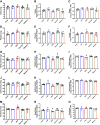The effects of diet composition and chronic obesity on muscle growth and function
- PMID: 33211595
- PMCID: PMC7944928
- DOI: 10.1152/japplphysiol.00156.2020
The effects of diet composition and chronic obesity on muscle growth and function
Abstract
Diet-induced obesity (DIO) is associated with glucose intolerance, insulin resistance (IR), and an increase in intramyocellular lipids (IMCL), which may lead to disturbances in glucose and protein metabolism. To this matter, it has been speculated that chronic obesity and elevated IMCL may contribute to skeletal muscle loss and deficits in muscle function and growth capacity. Thus, we hypothesized that diets with elevated fat content would induce obesity and insulin resistance, leading to a decrease in muscle mass and an attenuated growth response to increased external loading in adult male mice. Male C57BL/6 mice (8 wk of age) were subjected to five different diets, namely, chow, low-dat-diet (LFD), high-fat-diet (HFD), sucrose, or Western diet, for 28 wk. At 25 wk, HFD and Western diets induced a 60.4% and 35.9% increase in body weight, respectively. Interestingly, HFD, but not Western or sucrose, induced glucose intolerance and insulin resistance. Measurement of isometric torque (ankle plantar flexor and ankle dorsiflexor muscles) revealed no effect of DIO on muscle function. At 28 wk of intervention, muscle area and protein synthesis were similar across all diet groups, despite insulin resistance and increased IMCL being observed in HFD and Western diet groups. In response to 30 days of functional overload, an attenuated growth response was observed in only the HFD group. Nevertheless, our results show that DIO alone is not sufficient to induce muscle atrophy and contractile dysfunction in adult male C57BL/6 mice. However, diet composition does have an impact on muscle growth in response to increased external loading.NEW & NOTEWORTHY The effects of diet-induced obesity on skeletal muscle mass are complex and dependent on diet composition and diet duration. The present study results show that chronic exposure to high levels of fatty acids does not affect muscle mass, contractile function, or protein synthesis in obese C57BL/6 mice compared with the consumption of chow. Obesity did result in a delay in load-induced growth; however, only a 45% HFD resulted in attenuated growth following 30 days of functional overload.
Keywords: atrophy; hypertrophy; insulin resistance; intramuscular lipids; muscle function; obesity; skeletal muscle atrophy.
Figures











Similar articles
-
Enhanced lipid oxidation and maintenance of muscle insulin sensitivity despite glucose intolerance in a diet-induced obesity mouse model.PLoS One. 2013 Aug 12;8(8):e71747. doi: 10.1371/journal.pone.0071747. eCollection 2013. PLoS One. 2013. PMID: 23951235 Free PMC article.
-
High-fat diet-induced impairment of skeletal muscle insulin sensitivity is not prevented by SIRT1 overexpression.Am J Physiol Endocrinol Metab. 2014 Nov 1;307(9):E764-72. doi: 10.1152/ajpendo.00001.2014. Epub 2014 Aug 26. Am J Physiol Endocrinol Metab. 2014. PMID: 25159328 Free PMC article.
-
Long-term treatment with nicotinamide induces glucose intolerance and skeletal muscle lipotoxicity in normal chow-fed mice: compared to diet-induced obesity.J Nutr Biochem. 2016 Oct;36:31-41. doi: 10.1016/j.jnutbio.2016.07.005. Epub 2016 Aug 4. J Nutr Biochem. 2016. PMID: 27567590
-
A chronic high-fat diet exacerbates contractile dysfunction with impaired intracellular Ca2+ release capacity in the skeletal muscle of aged mice.J Appl Physiol (1985). 2020 May 1;128(5):1153-1162. doi: 10.1152/japplphysiol.00530.2019. Epub 2020 Mar 26. J Appl Physiol (1985). 2020. PMID: 32213111 Free PMC article.
-
Chronic high fat feeding attenuates load-induced hypertrophy in mice.J Physiol. 2009 Dec 1;587(Pt 23):5753-65. doi: 10.1113/jphysiol.2009.180174. Epub 2009 Oct 12. J Physiol. 2009. PMID: 19822547 Free PMC article.
Cited by
-
A chronic high-fat diet does not exacerbate muscle atrophy in fast-twitch skeletal muscle of aged mice.Exp Physiol. 2023 Jul;108(7):940-945. doi: 10.1113/EP091106. Epub 2023 Apr 19. Exp Physiol. 2023. PMID: 37074636 Free PMC article.
-
Geranylgeraniol and Green Tea Polyphenols Mitigate Negative Effects of a High-Fat Diet on Skeletal Muscle and the Gut Microbiome in Male C57BL/6J Mice.Metabolites. 2022 Sep 27;12(10):913. doi: 10.3390/metabo12100913. Metabolites. 2022. PMID: 36295815 Free PMC article.
-
Diet-induced Obesity: Pathophysiology, Consequences and Target Specific Therapeutic Strategies.Curr Protein Pept Sci. 2025;26(2):113-124. doi: 10.2174/0113892037329528240827180820. Curr Protein Pept Sci. 2025. PMID: 39225225 Review.
-
Dietary combination of sucrose and linoleic acid increases intramyocellular lipid and impairs muscle strength in female Zucker diabetic fatty rats.J Clin Biochem Nutr. 2025 May;76(3):271-279. doi: 10.3164/jcbn.24-229. Epub 2025 Jan 18. J Clin Biochem Nutr. 2025. PMID: 40510391 Free PMC article.
-
Prevalence and Mechanisms of Skeletal Muscle Atrophy in Metabolic Conditions.Int J Mol Sci. 2023 Feb 3;24(3):2973. doi: 10.3390/ijms24032973. Int J Mol Sci. 2023. PMID: 36769296 Free PMC article. Review.
References
-
- Pahlavani M, Ramalingam L, Miller EK, Scoggin S, Menikdiwela KR, Kalupahana NS, Festuccia WT, Moustaid-Moussa N. Eicosapentaenoic acid reduces adiposity, glucose intolerance and increases oxygen consumption independently of uncoupling protein 1. Mol Nutr Food Res 63: e1800821, 2019. doi:10.1002/mnfr.201800821. - DOI - PMC - PubMed
-
- Stenholm S, Sallinen J, Koster A, Rantanen T, Sainio P, Heliovaara M, Koskinen S. Association between obesity history and hand grip strength in older adults–exploring the roles of inflammation and insulin resistance as mediating factors. J Gerontol A Biol Sci Med Sci 66A: 341–348, 2011. doi:10.1093/gerona/glq226. - DOI - PMC - PubMed
Publication types
MeSH terms
Grants and funding
LinkOut - more resources
Full Text Sources
Other Literature Sources

